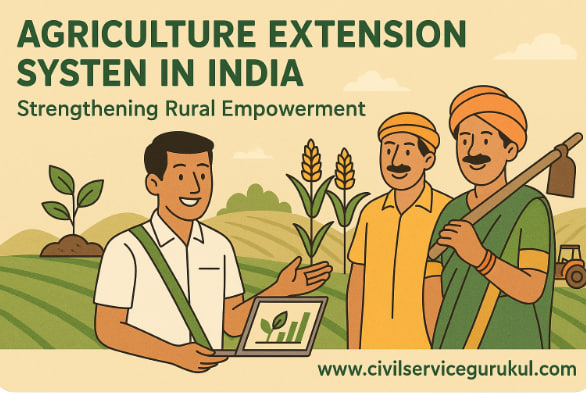Agriculture Extension System in India: Strengthening Rural Empowerment

India’s Trade Deficit: Challenges & Implications
June 20, 2025
Technical Textiles: Transforming India’s Textile Industry
June 23, 2025Agriculture Extension System in India: Strengthening Rural Empowerment
Why in News?
Recently, the Prime Minister awarded Krishi Sakhi certificates to over 30,000 women Self-Help Groups (SHGs) in Varanasi, recognizing their role in agricultural extension services.
Krishi Sakhis: Women-led Agricultural Extension
Who are Krishi Sakhis?
- Krishi Sakhis are practicing farmers trained as para-extension professionals at the grassroots level.
- They play a crucial role in India’s agriculture extension system by helping farmers adopt scientific and modern farming techniques.
Role of Krishi Sakhis
- Provide doorstep guidance on natural farming, soil health management, and capacity building.
- Help farmers understand new agricultural technologies and practices to enhance productivity.
- Act as a bridge between scientific research and farmers, ensuring effective adoption of agricultural innovations.
Krishi Sakhi Convergence Program (KSCP)
- Launched by: Ministry of Agriculture & Farmers’ Welfare (MoA&FW) and Ministry of Rural Development.
- Aim:
- To train and certify Krishi Sakhis as Para-extension Workers.
- To empower rural women and enhance agricultural outreach.
- To create 70,000 Krishi Sakhis, focusing on natural farming and soil health management.
- Linked to the Lakhpati Didi Program: Aims to create 3 crore women entrepreneurs, with Krishi Sakhis playing a vital role.
- Implementation:
- Phase 1 covers 12 states: Gujarat, Tamil Nadu, Uttar Pradesh, Madhya Pradesh, Chhattisgarh, Karnataka, Maharashtra, Rajasthan, Odisha, Jharkhand, Andhra Pradesh, and Meghalaya.
- Over 34,000 Krishi Sakhis have been certified so far.
India’s Agricultural Extension System
What is Agricultural Extension?
- It refers to programs and initiatives that help farmers apply scientific research and modern agricultural practices for better productivity.
- It involves education, training, and information-sharing.
Key Players in India’s Agricultural Extension
1. Public Sector Initiatives
- Indian Council of Agricultural Research (ICAR):
- Leads agricultural research and extension efforts in India.
- Implements ICT-based initiatives like VISTAAR, which uses videos for farm technology dissemination.
- Collaborates on big data projects for technology adoption strategies.
- National Mission on Agriculture Extension & Technology (NMAET):
- Aims to enhance agricultural productivity through technology adoption.
- Has four sub-missions:
- Sub-Mission on Agricultural Extension (SMAE).
- Sub-Mission on Seed & Planting Material (SMSP).
- Sub-Mission on Agricultural Mechanization (SMAM).
- Sub-Mission on Plant Protection & Plant Quarantine (SMPP).
- Krishi Vigyan Kendras (KVKs):
- Serve as field research units of ICAR.
- Conduct on-farm trials, farmer training, and demonstration projects.
- Help test new seed varieties, agronomic techniques, and machinery before large-scale adoption.
- ICT-led Interventions:
- m-Kisan and Kisan Call Centres help farmers receive expert advice via mobile.
2. Private Sector Involvement
- Agro-based companies like IFFCO, KRIBHCO, and input dealers provide advisory services.
- Private firms conduct farmer training programs on seed selection, fertilizer usage, and farm machinery adoption.
Challenges in India’s Agricultural Extension System
- Lack of Investment:
- Only 0.16% of India’s agri-GDP is allocated to agricultural extension services, making outreach limited.
- Regional Imbalances:
- Eastern states (e.g., Bihar, Odisha, Jharkhand) receive lower investments, despite high dependency on agriculture.
- Imbalance in Sectoral Allocation:
- 92% of extension funds go to crop husbandry, while livestock and fisheries remain neglected, despite their significant contribution to India’s agri-GDP.
- Outcome Deficit:
- The public extension system focuses on activity-based initiatives rather than outcome-driven improvements.
Way Forward: Strengthening Agricultural Extension in India
- Transition to a Market-Oriented Approach:
- Extension services should shift focus from food security to market-led farming.
- Strengthening Research-Extension Linkages:
- Encourage collaboration between research institutions, private players, and NGOs.
- Diversification Beyond Crop Farming:
- More investment in livestock, fisheries, and agro-processing is required to reduce dependence on crops.
- Leveraging Digital & Innovation Networks:
- Use AI, big data, and mobile-based advisory services for better outreach.
- Example: Ranking of Krishi Vigyan Kendras (KVKs) on the “DARPAN” portal for performance monitoring.
- Public-Private Partnerships (PPP-P):
- Encourage private players to collaborate with public institutions for technology dissemination.
- Development of Agri-Rural Markets:
- Establish Primary Agri-Rural Markets (PRAMs) for logistics, grading, and price discovery.
Multiple Choice Questions (MCQs)
1. What is the primary role of Krishi Sakhis in India’s agricultural extension system?
(a) They act as financial advisors for SHGs.
(b) They provide legal aid to farmers regarding land disputes.
(c) They serve as grassroots para-extension workers, guiding farmers in natural farming and soil health management.
(d) They are responsible for formulating agricultural policies at the state level.
Answer: (c) They serve as grassroots para-extension workers, guiding farmers in natural farming and soil health management.
2. Which of the following statements about India’s agricultural extension system is correct?
(a) The private sector does not play any role in agricultural extension services.
(b) National Mission on Agriculture Extension & Technology (NMAET) consists of four sub-missions, including mechanization and seed development.
(c) Krishi Vigyan Kendras (KVKs) primarily conduct agricultural research without interacting with farmers.
(d) ICT-based interventions like m-Kisan have not been implemented in India.
Answer: (b) National Mission on Agriculture Extension & Technology (NMAET) consists of four sub-missions, including mechanization and seed development.

